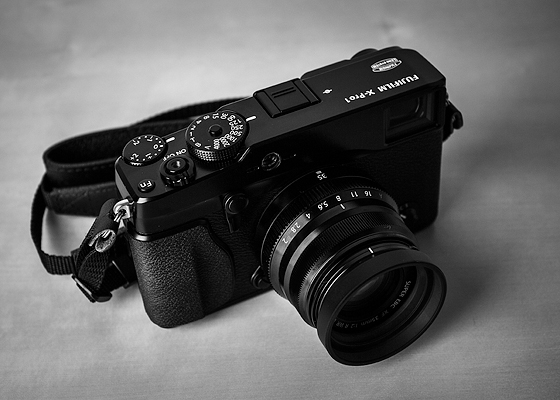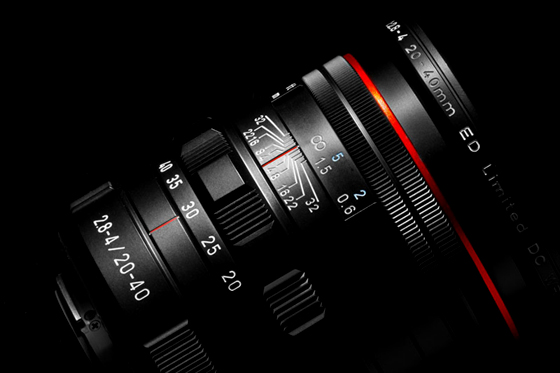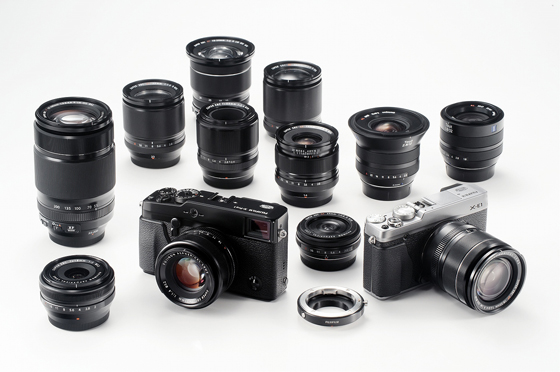FUJIFILM X-PRO1.
NOTEWORTHY CAMERA.

April 18, 2016.
For a long time now, I've been looking for a small, lightweight camera, that would allow me to travel undisturbed through the landscape, without having to compromise too much on image quality. At the same time, I had such a timid wish, that the camera could make me happy and inspire me with its appearance. The new modern DSLRs are technically very advanced, but they lack the beauty and nobility of classical devices.
The most important thing, however, was a large selection of high-quality monofocal (prime) lenses. At first, Pentax met this condition well.

Their beautiful Limited lenses are a delight to the photographer's eye twice - once when looking at them and the second time when viewing photographies. The recently introduced Pentax K-1 is proof, that the company has probably gone in the right direction, the camera is very interesting in all aspects. But the sensor is by Sony, same one as in the Nikon D810, to which I have my reservations mainly in color rendering and in addition I already one large, full-format device here have. The option was a cheap device too, such as the K-50, but this camera seemed just too compromised.
So, for the first time, I started looking around for compact cameras with interchangeable lenses. The condition was an APS-C-sized sensor, which immediately dropped the Olympus, which I would otherwise quite like. Sony didn't pass either, after all, I already have Nikon at home. And so, somehow, everything started pointing at Fujifilm. In addition, now that the new X-Pro2 model has appeared, the X-Pro1 can be purchased for a quarter of the original price. Even with two beautiful, speed monofocal (prime) lenses, Fujifilm XF 18 mm f/2,0 R and XF 27 mm f/2,8, I paid 24 000 CZK with VAT, which is still only half the price of the new X-Pro2. Of course, it brings some improvements, especially the sensor with 24 million points compared to sixteen at the X-Pro1. But if you look at the development of X-Pro1 prices, you will find, that sometimes in two years it should be half cheaper and then the right time will be to buy X-Pro2.
I don't have much time to write a long article right now, and I'm still getting used to the camera. So I will write at least briefly the advantages and disadvantages of the new device, I will hopefully get to the rest later.
+ Quality of photographs: monofocal speed lenses + sensor almost at the rear element + Fujifilm APS-C X-Trans without AA filter with different architecture of a Bayer mosaic + perfectly prepared characteristics of legendary films (Velvia, Astia, Provia, ... – who would know better, than their manufacturer) = incredible quality photographs with creamy, velvety rendering of areas outside the field of sharpness, perfectly drawn details and clean, vibrant colors. I didn't want to believe it for a long time, but photographs from Fujifilm X-Pro1 with monofocal optics not only match images from D3x, but even, when I omit the difference given by resolution, even from 5DSR. Colors, detailcontrast, aesthetic appearance of noise at higher sensitivities - if I didn't try, I wouldn't believe it.
+ Lenses: a range of beautiful, metallic, high-speed (just from 1:1.2) prime lenses at relatively affordable prices (10 000 – 53 000,- CZK with VAT). Also lenses with variable focal length and optical stabilization (up to +5 EV) including two with fixed 2.8. In addition, with most lenses the aperture is adjusted pleasantly mechanically using a ring. All optical elements are always made of glass.

I also bought to the two above mentioned Fujinon XF 35 mm f/2R WR. This lens, in conjunction with the APS-C sensor, is a classic fifty, my favorite focal length. It is light, all-metal, sealed against dust and moisture, the manufacturer also guarantees trouble-free operation up to -10 degrees Celsius. The rings run firmly, precisely. Thanks to the internal focusing and stepper motor, the lens works in a flash and almost inaudibly. And photographs? Such incredibly, precise drawing is seldom seen. The images excel in spatial impression and are very artistic and inspiring in nature.
+ Appearance: beautiful rangefinder style camera, all-metal magnesium body, mechanical control of exposure times and exposure correction with metal wheels; trigger with thread for wired shutter and on/off switch as with Nikon. Made in Japan.
+ Dimensions: due to the quality of the photographs, it is unbelievable, that you can hide this camera in a larger pocket of your jacket, if necessary. It is also very light.
– Controls and dimensions: for a professional, used to work with a large DSLR camera, one cold shower after another from the beginning. Unable to enlarge the image after photographing so that the sharpness of the image can be checked - the magnification is too small. Optical viewfinder parallax, jumping focus point. You can see the lens in the viewfinder. At the beginning, I accidentally touch the screen or the viewfinder at any moment. What to take it for? Won't it fall out of my hand? Shifted thread for the tripod plate - a large plate will help, but it will reliably cover the space for the battery, where the memory card is also hidden. So I ordered a thing, that will both create a larger camera handle on the right, move the tripod screw where it belongs, ie into the optical axis and, last but not least, allow you to remove the memory card or battery even if the camera is placed on a tripod. The lower metal bar is also profiled, so that it can be used as a long tripod plate. Which is good, but not for me, because Gitzo is not, one of the few, Arca Swiss profiles to use. The price is less pleasant - for this tripod plate with a handle it is necessary to pay equal to 3000 CZK with VAT ...
– Artifacts in an image: during tests in the atelier not, but in nature, when photographing at a greater distance, e.g. in grass, leaves, etc., these sometimes merge into some units, that look like a painting or as a result of strong internal noise. With the friend ►Jan we underwent a ruthless analytical analysis according to the methodology of the Just brothers, while we found, that the blame in Adobe Lightroom, respectively, its too large sharpening radius (1). Therefore, if these phenomena occur, it is necessary to refine the sharpening, respectively, slightly change its settings. Clarity increasing helps too. What is important, however, is that these artifacts do not arise from a noise reduction program in the camera, that interferes RAWs (RAFs). It probably will be there, but fortunately works without consequences.
– Missing lenses: longest focal length (unless I count variable focal length lenses) has at this time Fujinon XF 90 mm f/2.0 R LM WR, 36 mm film equivalent 135 mm. I would welcome two speed telephoto lenses 200 mm f/2.8 and 300 mm f/4, therefore 300 and 450 mm 36 mm film equivalent. The three hundred (450) please with stabilization for birds. A new macro lens was also introduced last February, XF 120 mm f/2.8 R Macro OIS WR, but not yet on sale. Existing only macro lens XF 60 mm F2.4 R Macro offers magnification only 1:2, which in many cases not enough.
So much for now and in a nutshell. If you are thinking about a similar device and you can get used to the sometimes a bit awkward operation, so far I can only and only recommend.
© Martin Mojzis, 2016.
Photographs: © Martin Mojzis, 2016 (introductory photograph of the camera), © Pentax - Ricoh, © Fujifilm.
►Fujifilm X-Trans: Apparently the final farewell.
►Fujifilm X-Trans: No more unwanted artifacts.
►To the beginning of the article.
►Overview of all articles.
►Homepage.
►Site Map.